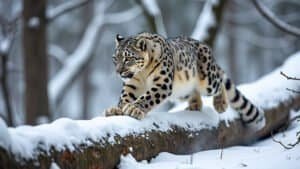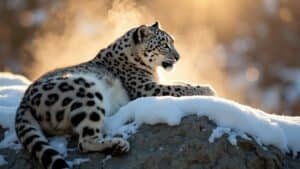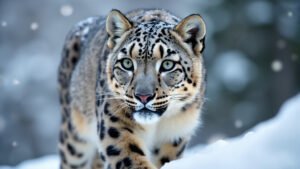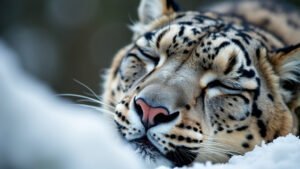Introduction
The Snow Leopard Trust is dedicated to the conservation of snow leopards and their habitats. This article explores the various efforts made by the organization, including conservation strategies, community engagement, and research initiatives
Additionally, it highlights the Trust’s key achievements, ways individuals can support their mission, and the challenges faced in snow leopard conservation. By understanding these aspects, we can better appreciate the critical work being done to protect these magnificent creatures
Snow Leopard Conservation Efforts
Snow leopard conservation is a multifaceted effort that encompasses various strategies, community engagement, and research initiatives. The Snow Leopard Trust is at the forefront of these efforts, working tirelessly to ensure the survival of this elusive big cat
Conservation Strategies
The Snow Leopard Trust employs a range of strategies to conserve snow leopards. One of the primary methods is habitat protection
By working with local governments and communities, the Trust helps establish and manage protected areas that are critical to the survival of snow leopards. These protected areas provide safe havens where snow leopards can thrive without the threat of poaching or habitat destruction
Additionally, the Snow Leopard Trust promotes sustainable practices among local populations. This includes initiatives such as livestock insurance programs, which compensate herders for livestock losses due to snow leopard predation. By mitigating the economic impact of snow leopard attacks, these programs reduce the incentive for retaliatory killings of the cats
Community Engagement
Engaging local communities is essential to the success of conservation efforts. The Snow Leopard Trust understands that the people living in snow leopard habitats are key stakeholders in the conservation process. As a result, the Trust works closely with these communities to develop programs that benefit both the people and the wildlife
One notable program is the Snow Leopard Enterprises initiative, which provides training and resources to local artisans, allowing them to create and sell handicrafts
This not only generates income for the communities but also fosters a sense of ownership and pride in conserving snow leopards. By linking conservation with tangible benefits, the Snow Leopard Trust ensures long-term support from local populations
Education is another crucial aspect of community engagement. The Trust conducts educational workshops and outreach programs to raise awareness about the importance of snow leopards and the challenges they face. These programs aim to inspire a new generation of conservationists who will continue to protect snow leopards in the future
Research and Monitoring
Research is a cornerstone of the Snow Leopard Trust’s conservation efforts. By studying snow leopards and their habitats, the Trust can develop more effective strategies for protecting them
One of the primary research tools used by the Trust is camera trapping. These cameras, placed in strategic locations, capture images of snow leopards in the wild, providing valuable data on their numbers, behavior, and movements
In addition to camera traps, the Snow Leopard Trust employs GPS collaring to track individual snow leopards. This technology allows researchers to monitor the movements of collared cats in real time, gaining insights into their range, habitat use, and interactions with humans and livestock. This information is crucial for designing targeted conservation interventions
Genetic studies also play a vital role in snow leopard research. By analyzing genetic samples from scat and other sources, the Snow Leopard Trust can assess the genetic diversity of snow leopard populations and identify distinct subpopulations
This helps in understanding the connectivity between different populations and the potential for inbreeding, which can inform conservation planning
Overall, the Snow Leopard Trust’s comprehensive approach to conservation, combining habitat protection, community engagement, and cutting-edge research, ensures that snow leopards have the best possible chance of survival
By addressing the needs of both the wildlife and the people who share their habitats, the Trust creates a sustainable model for conservation that can be replicated in other regions facing similar challenges
Key Achievements of the Snow Leopard Trust
The Snow Leopard Trust has made significant strides in the conservation of snow leopards since its inception. These achievements are a testament to the organization’s dedication, innovative approaches, and effective collaboration with various stakeholders
Milestones Reached
One of the most notable milestones achieved by the Snow Leopard Trust is the establishment of protected areas. Over the years, the Trust has successfully worked with local governments and communities to create numerous protected zones across the snow leopard’s range
These areas serve as safe havens, reducing the risk of poaching and habitat destruction. For instance, the creation of the Tost Tosonbumba Nature Reserve in Mongolia in 2016 was a major achievement, covering over 1.8 million acres and providing critical habitat for snow leopards
Another significant milestone is the implementation of the Snow Leopard Enterprises program. This initiative has empowered hundreds of local families by providing them with alternative sources of income through the production and sale of handicrafts
As a result, these communities have become active partners in conservation, reducing their dependence on livestock and mitigating human-wildlife conflict
The Trust’s efforts in scientific research have also yielded remarkable results. For example, the extensive camera trapping and GPS collaring programs have provided invaluable data on snow leopard populations, behavior, and movements
This research has led to a better understanding of snow leopard ecology and has informed conservation strategies not only for the Snow Leopard Trust but also for other organizations and governments
Success Stories
The Snow Leopard Trust’s work has led to numerous success stories, showcasing the positive impact of their initiatives. One such story is that of the community-managed conservation areas in Pakistan. In these areas, local communities take the lead in managing and protecting snow leopard habitats
The Trust provides technical support and training, but it is the local people who are the driving force behind the conservation efforts. This model has proven highly effective, resulting in increased snow leopard sightings and reduced poaching incidents
In Kyrgyzstan, the Trust’s conservation programs have led to a significant decline in snow leopard poaching. Through the Livestock Insurance Program, herders are compensated for losses caused by snow leopards, which has greatly reduced retaliatory killings
This program, combined with community education and engagement, has fostered a more harmonious coexistence between humans and snow leopards
Another success story comes from India, where the Trust’s education and awareness campaigns have inspired a new generation of conservationists
Schoolchildren in snow leopard habitats are now more knowledgeable about the importance of protecting these big cats. Many of these children have become ambassadors for snow leopard conservation, spreading the message within their communities and beyond
The Snow Leopard Trust’s collaboration with other organizations has also been instrumental in their success. By partnering with governments, NGOs, and research institutions, the Trust has amplified its impact and extended its reach
For instance, the Global Snow Leopard & Ecosystem Protection Program (GSLEP), launched in 2013, is a collaborative effort involving all 12 snow leopard range countries. This initiative aims to secure 20 snow leopard landscapes by 2020, representing a major step forward in international snow leopard conservation
The combination of innovative programs, community engagement, and strategic partnerships has enabled the Snow Leopard Trust to achieve significant milestones and create lasting positive impacts on snow leopard conservation
These achievements highlight the effectiveness of their approach and serve as a model for other conservation organizations worldwide
Supporting the Snow Leopard Trust
Supporting the Snow Leopard Trust is essential for the continued success of its conservation efforts. There are various ways individuals and organizations can contribute to the mission of protecting snow leopards and their habitats
How to Get Involved
There are numerous ways to get involved with the Snow Leopard Trust. One of the simplest methods is through direct donations
Monetary contributions help fund the Trust’s various programs, from research initiatives to community engagement efforts. Donations can be made as one-time gifts or as recurring contributions, providing ongoing support for the Trust’s work
Another way to support the Snow Leopard Trust is by purchasing products from their online store. The store offers a range of items, including handmade crafts from the Snow Leopard Enterprises program. By buying these products, supporters not only contribute financially but also help provide income for local communities living in snow leopard habitats
Participating in awareness campaigns and fundraising events is another effective way to support the Trust. The organization regularly hosts events such as charity runs, auctions, and educational workshops. These events raise both funds and awareness, engaging a broader audience in snow leopard conservation
Donation and Fundraising
Donations are the lifeblood of the Snow Leopard Trust. Financial contributions from individuals, corporations, and foundations enable the Trust to carry out its critical conservation work
Donors can choose to support specific projects, such as anti-poaching initiatives, habitat restoration, or research programs. The Trust also offers options for planned giving, allowing supporters to include the organization in their wills or estate plans
In addition to direct donations, fundraising is a vital component of the Snow Leopard Trust’s support structure. Individuals can organize their own fundraising events, such as bake sales, community runs, or online crowdfunding campaigns. The Trust provides resources and guidance for those interested in hosting their own events, making it easy to contribute in meaningful ways
Corporate partnerships are another important aspect of fundraising. Businesses can support the Snow Leopard Trust through sponsorships, cause-related marketing, and employee giving programs. These partnerships not only provide financial support but also help raise awareness of snow leopard conservation among a wider audience
Volunteer Opportunities
Volunteering with the Snow Leopard Trust offers hands-on ways to contribute to conservation efforts
While opportunities for direct involvement in the field are limited due to the remote and challenging nature of snow leopard habitats, there are numerous ways to help from afar. Volunteers can assist with administrative tasks, help organize events, or participate in outreach and education efforts
For those interested in more immersive experiences, the Trust occasionally offers volunteer positions in their research programs. These positions may involve assisting with camera trapping, data collection, or community engagement projects. Volunteers gain valuable experience in conservation work while contributing directly to the Trust’s mission
Additionally, the Snow Leopard Trust welcomes virtual volunteers who can help with tasks such as social media management, graphic design, and content creation. These roles are ideal for individuals who want to use their skills to support conservation efforts from anywhere in the world
Supporting the Snow Leopard Trust through donations, fundraising, and volunteering is crucial for the continuation and expansion of its vital conservation programs. Each contribution, no matter how small, helps ensure a future where snow leopards can thrive in their natural habitats
Challenges in Snow Leopard Conservation
Conserving snow leopards involves overcoming several significant challenges. These challenges range from environmental threats to human-wildlife conflict and the ongoing need for adequate funding and resources
Environmental Threats
One of the primary challenges in snow leopard conservation is the array of environmental threats these animals face
Climate change is a major concern, as it alters the habitat and prey availability for snow leopards. Rising temperatures and changing precipitation patterns can lead to a reduction in the alpine habitats that snow leopards depend on
Additionally, climate change can affect the populations of prey species such as ibex and blue sheep, forcing snow leopards to venture closer to human settlements in search of food
Habitat fragmentation is another significant environmental threat. As human populations grow and expand into previously untouched areas, the natural habitats of snow leopards become increasingly fragmented
This fragmentation isolates populations, making it more difficult for snow leopards to find mates and reducing genetic diversity. Furthermore, it increases the likelihood of human-wildlife conflict as snow leopards are forced into closer proximity with people and livestock
Poaching and illegal wildlife trade also pose serious threats to snow leopards. Despite legal protections, snow leopards are often targeted for their beautiful fur and body parts, which are used in traditional medicine
Efforts to combat poaching are ongoing, but it remains a persistent issue that requires constant vigilance and robust enforcement of wildlife protection laws
Human-Wildlife Conflict
Human-wildlife conflict is a pervasive challenge in snow leopard conservation. Snow leopards often prey on livestock, which can lead to significant economic losses for herders. In retaliation, herders may kill snow leopards to protect their livelihoods
This conflict creates a cycle of violence that threatens both snow leopard populations and the well-being of local communities
The Snow Leopard Trust has developed several programs to mitigate human-wildlife conflict. One such initiative is the Livestock Insurance Program, which compensates herders for losses caused by snow leopard predation
By reducing the economic impact of livestock losses, this program decreases the motivation for retaliatory killings. The Trust also works with communities to improve livestock management practices, such as building predator-proof corrals, which can help protect livestock from snow leopard attacks
Education and awareness campaigns are also crucial in addressing human-wildlife conflict. By educating local communities about the ecological importance of snow leopards and the benefits of conservation, the Snow Leopard Trust fosters a greater understanding and appreciation for these animals. This, in turn, helps build local support for conservation initiatives and reduces instances of conflict
Funding and Resources
Adequate funding and resources are essential for the success of snow leopard conservation efforts. The Snow Leopard Trust relies on donations, grants, and partnerships to fund its various programs
However, securing consistent and sufficient funding is a constant challenge. Conservation work is often expensive, requiring resources for research, community engagement, anti-poaching efforts, and more
One way the Trust addresses this challenge is through innovative fundraising strategies. The Snow Leopard Enterprises program, for example, not only supports local communities but also generates revenue for conservation activities
Additionally, the Trust engages in various fundraising campaigns and seeks support from corporate partners and philanthropic foundations
Collaboration with other organizations and governments is also key to overcoming resource challenges. By working together, these entities can pool resources, share knowledge, and coordinate efforts to maximize the impact of conservation initiatives
The Global Snow Leopard & Ecosystem Protection Program (GSLEP) is an example of such collaboration, bringing together range countries to work towards common conservation goals
Despite these efforts, the need for more funding and resources remains. The Snow Leopard Trust continuously seeks new ways to engage supporters and secure the financial stability necessary to carry out its mission
Overcoming the challenges in snow leopard conservation requires a multifaceted approach, addressing environmental threats, human-wildlife conflict, and the need for adequate funding and resources. By tackling these issues head-on, the Snow Leopard Trust strives to create a future where snow leopards can coexist harmoniously with human communities and thrive in their natural habitats
Conclusion
The Snow Leopard Trust is dedicated to the conservation of snow leopards through a combination of habitat protection, community engagement, and scientific research
The organization’s efforts have led to significant achievements, such as the establishment of protected areas and the implementation of community-based conservation programs. By involving local communities, the Trust ensures sustainable conservation practices that benefit both wildlife and people
Support for the Snow Leopard Trust comes in many forms, including donations, fundraising, and volunteering. These contributions are crucial for the continuation of the Trust’s work, addressing challenges such as environmental threats, human-wildlife conflict, and the need for sufficient funding
Through innovative programs and strategic partnerships, the Snow Leopard Trust continues to make strides in protecting snow leopards and their habitats. Together, we can support these efforts and help secure a future for these magnificent creatures











